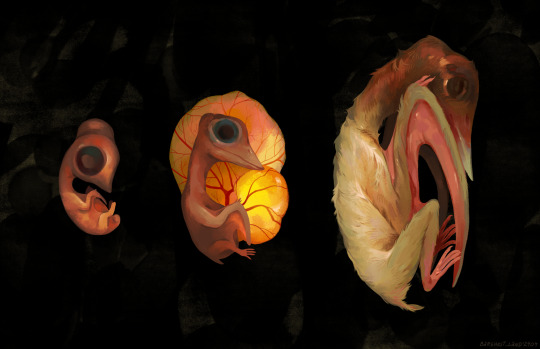Text
Talenkauen santacrucensis
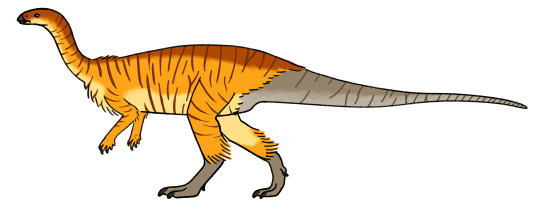
Talenkauen was a genus of neornithischian dinosaur from the Late Cretaceous period. Its type species is T. santacrucensis. The only specimen was found on Los Hornos Hill on the coast of Viedma Lake in Patagonia, Argentina. This specimen was found lying next to a scattering of fragmentary bones and teeth, which has been identified as a recently-hatched baby T. santacrucensis.
Talenkauen means "small skull;" its root words "talenk" and "kauen" originate from the Aonikenk language.
Its autapomorphies include a well–developed epipophysis on cervical 3 and plate–like unicate processes on the rib cage.
Talenkauen was a bipedal herbivorous dinosaur. It was at most 4 meters long, with a similar build to Dryosaurus, having short limbs, a long trunk and neck, and a small head. It was found to be closely related to Macrogryphosaurus and the clade Elasmaria was erected for the two genera. As of 2019, Elasmaria now includes almost a dozen genera.
Original paper: Novas, Fernando E.; Cambiaso, Andrea V; Ambrioso, Alfredo (2004). "A new basal iguanodontian (Dinosauria, Ornithischia) from the Upper Cretaceous of Patagonia". Ameghiniana. 41 (1): 75–82.
Wikipedia article: https://en.m.wikipedia.org/wiki/Talenkauen
20 notes
·
View notes
Text

The huge 4.5-meter-long coelacanth Mawsonia gigas prepares an ambush among a few logs deep in the murky estuarine waters of what is now the Kem Kem Beds of Morocco, 96 million years ago.
318 notes
·
View notes
Text
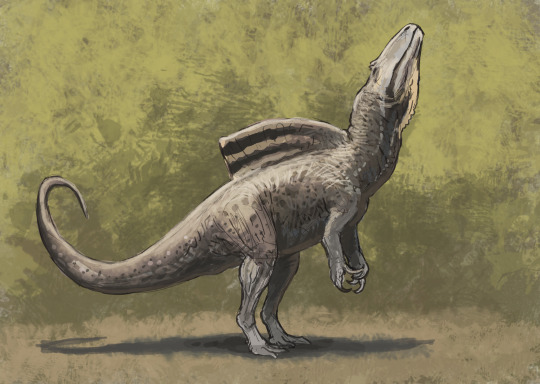


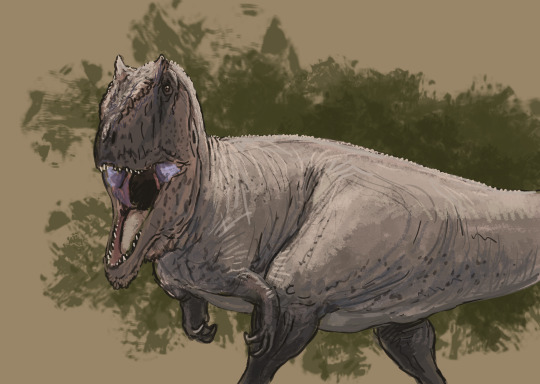
Results from the Flocking #paleostream!
Altispinax, Thyreosaurus, Ornithoprion and Mapusaurus.
471 notes
·
View notes
Text

Trilobozoans (also known as triradialomorphs) are some of the more enigmatic members of the Ediacaran biota. In the past their unique three-way-symmetrical body plan was interpreted as linking them to groups like sponges, cnidarians, or echinoderms, but currently they're considered to be their own weird little phylum with uncertain evolutionary affinities, classified no more specifically than "probably some sort of early eumetazoan animal".
Lobodiscus tribrachialis is a newly-described member of this mysterious lineage. It lived in warm shallow marine waters covering what is now Southwestern China, and with an age of around 546 million years it's currently the youngest known trilobozoan, extending the group's time range by several million years.
About 3.7cm in diameter (~1.5"), it had the characteristic trilobozoan disc-shaped shield-like body, with a central depression surrounded by three triradially-symmetric lobes with branching ridges and grooves.
Its body would have been soft but fairly rigid, and it's not clear if it was capable of moving over the seafloor or if it had a more static lifestyle. Like its relative Tribrachidium it was probably a filter feeder, with the grooves on its surface directing water flow towards the central depression – and this surface ornamentation may also have been covered with cilia that actively caught and transported suspended food particles.
———
NixIllustration.com | Tumblr | Patreon
References:
Ivantsov, A. Yu, and M. A. Zakrevskaya. "Trilobozoa, Precambrian tri-radial organisms." Paleontological Journal 55 (2021): 727-741. https://doi.org/10.1134/S0031030121070066
Ivantsov, Andrey, Aleksey Nagovitsyn, and Maria Zakrevskaya. "Traces of locomotion of Ediacaran macroorganisms." Geosciences 9.9 (2019): 395. https://doi.org/10.3390/geosciences9090395
Hall, C. M. S., et al. "The short-lived but successful tri-radial body plan: a view from the Ediacaran of Australia." Australian Journal of Earth Sciences 67.6 (2020): 885-895. https://doi.org/10.1080/08120099.2018.1472666
Rahman, Imran A., et al. "Suspension feeding in the enigmatic Ediacaran organism Tribrachidium demonstrates complexity of Neoproterozoic ecosystems." Science Advances 1.10 (2015): e1500800. https://doi.org/10.1126/sciadv.1500800
Zhao, Mingsheng, et al. "A putative triradial macrofossil from the Ediacaran Jiangchuan Biota." Iscience 27.2 (2024). https://doi.org/10.1016/j.isci.2024.108823
Wikipedia contributors. “Lobodiscus.” Wikipedia, 29 Mar. 2024, https://en.wikipedia.org/wiki/Lobodiscus
Wikipedia contributors. “Trilobozoa.” Wikipedia, 10 Mar. 2024, https://en.wikipedia.org/wiki/Trilobozoa
294 notes
·
View notes
Text
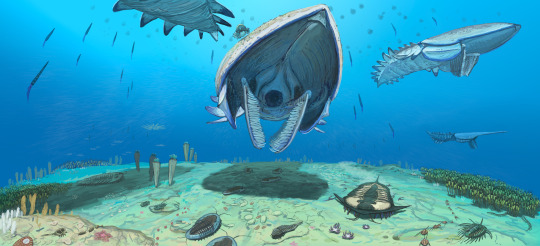

Result from the Fezouata formation #paleostream!
Behold the emperor of the Ordovician visits its benthic subjects!
#bathmoceras#clonograptus#dikelokephalina#plumalina#pirania#plumulites#xiphosuran#calvapilosa#tarfaya#aegirocassis#pseudoangutidontus#megistapis#selenopeltis#asaphellus#tremeglaspis#geragnostus#araneograptus#plasiacystis#rhopalocystis#villebrunaster
317 notes
·
View notes
Photo

Two very tall sword-bearer Arambourgiania.
62 notes
·
View notes
Text

Dinocephalosaurus orientalis was a fully aquatic protorosaur reptile living in what is now southwest China during the mid-Triassic, about 244 million years ago.
Up to 6m long (~19'8"), it had a long serpentine body with paddle-like limbs and an especially elongated neck – but despite the superficial similarities to its semi-aquatic cousin Tanystropheus, Dinocephalosaurus' long neck appears to have been independently evolved.
Much like the similarly-shaped elasmosaurs, its neck may have had a "stealth" function, allowing it to bring its jaws closer to targets before the rest of its body was visible, then using side-to-side snapping bites to catch its prey in its interlocking "fish-trap" teeth.
A preserved well-developed embryo inside one specimen also suggests that Dinocephalosaurus gave birth to live young, making it one of only two archosauromorph lineages known to have ever evolved this reproductive strategy.
———
NixIllustration.com | Tumblr | Patreon
228 notes
·
View notes
Text




Results from the Flocking #paleostream!
The Will Of The People decided for a invertebrate stream today! Tyrannasorus rex, Titanomyrma, Hibbertopterus and Proteroctopus.
130 notes
·
View notes
Text

Day 24: Parocnus browni
A Pygmy ground sloth from Cuba and Hispaniola of Pleistocene and Holocene, is sleepy on a half fallen palm tree in a dense jungle of Cuba.
46 notes
·
View notes
Photo

Ancient herbivore’s diet weakened teeth and lead to eventual starvation, suggests study
A team of researchers from the University of Bristol have shed light on the life of an ancient rhynchosaur reptile, which walked the earth between 250-225 million years ago, before being replaced by the dinosaurs.
sulc.us/rhynchosaurB
47 notes
·
View notes
Text

While plants are certainly not my specialty, without them life today would be significantly different.
Cooksonia was one of the earliest plants to colonize the land during the Silurian period. It was simple and barely taller than a pin. The cup-shaped ends of their leafless branches could produce microscopic spores which would travel through the air and spread across the barren continents
This early plant grew in mud and other damp, low-lying habitats forming dense mats, similar to algae or mold. Terrestrial plants were pioneers in their time, and would pave the way for life to thrive on the surface.
16 notes
·
View notes
Text
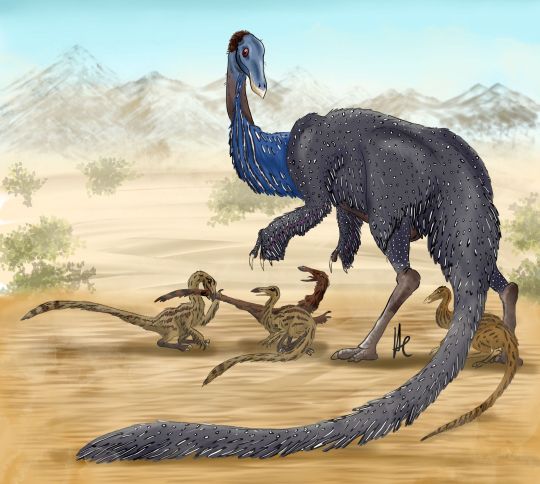
Doodled some ornithomimid dinosaurs at work and decided to flesh it out more with my tablet at home. Gallimimus parent with some unruly offspring in a lazily drawn deserty environment (they were from late cretaceous mongolia). the colors of the parent are inspired by todays vulturine guineafowl.
under the cut is the original work doodle

193 notes
·
View notes
Text

Final for my Allosaurus jimmadseni portrait.
216 notes
·
View notes
Text

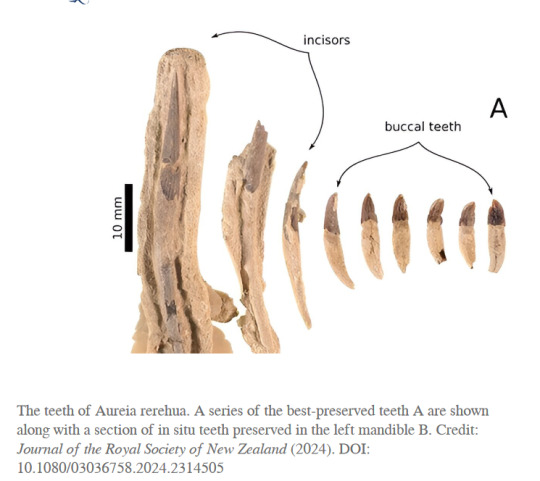
Images of the fossil skull of Aureia rerehua.
Source.
9 notes
·
View notes
Text
The fossil consists of a femur, tibia, hip and hip socket—enough for the team to identify it as belonging to a group known as Theria, which comprises non-egg-laying mammals. It also was enough to show that the animal was large compared to other mammals of its time. The team named the new creature, Patagomaia chainko. It was excavated in southern Patagonia.
They describe it as a medium-sized mammal compared to today's standards, likely about the size of an Andean fox. They suggest the size of the species on average could have varied from 2 to 25 kilograms and that it likely grew to be about a meter long; it lived approximately 70 million years ago.
22 notes
·
View notes
Text

This Amphicyon got lucky! It's prey, a large male Oncorhynchus rastrosus already spawned and was in the process of dying.
#amphicyon#oncorhynchus rastrosus#i wonder if the smell of a rastrosus salmon run would be much different than a modern salmon run.#i assume it would be stronger.#that's an impressive visual to imagine. all these big rastrosus rotting and floating along the creekbeds.#if you've ever been to a salmon run. it has it's own unique beauty.#i'm lucky to live very close to areas where there are runs so i attended several field trips to watch them.
1K notes
·
View notes
